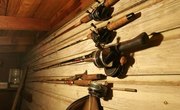
Regardless of your age or level of fishing expertise, there is something just plain fun about a Zebco spin-cast reel. These reels are easy to use, reliable, well built and most of all catch fish. However, from time to time it may be necessary to troubleshoot problems with a Zebco reel and make repairs. Typically requiring only a few basic tools, most anglers should have no problem making minor repairs.
Items you will need
Zebco reel
Schematic diagram
Clean rags
Reel oil
Cotton swab
Old toothbrush
Refer to a schematic drawing of your Zebco reel. A schematic is an exploded diagram of your reel that shows all of the parts and how they fit together. This is a good way to become familiar with your reel and can also prove very useful when assembling the reel after cleaning repairs.
Determine the source of the problem with the reel. There are several main parts of the reel that may need repair. These include the handle, spool and cover, spool-release button and gears. The best ways to begin evaluating the reel are visual inspection and turning the handle to observe problems.
Clean and lubricate the handle if it is hard to turn. Use a toothbrush to remove any old grease and apply a few drops of reel oil. If the drag star is sticking or will not turn, cleaning may be the solution.
Order replacement parts when necessary. A broken spool-release button or spool cover cannot typically be repaired. Replacement parts can be obtained from Zebco.
Remove the rear spool cover, when possible, and examine the gears for lack of lubrication or too much grease. Either can lead to operating issues. If there is too much grease or old grease present, use a cotton swab to remove the excess and apply reel oil to the moving gears and parts. Thoroughly lubricate the gears and moving parts if there is a lack of lubrication on the parts.
Attempt to cast or pull line from the spool. If line will not spool from the reel, make sure the spool-release button is pressed and remove the spool cover by rotating it slightly and pulling straight out. Check that there is enough line spooled on the reel and there are no knots or bird nest tangles in the line. Also, make sure the correct pound-test line is being used for the type and weight of lure or bait.
Tips
- Completely re-assemble the reel after making repairs.
- Use clean cloth with a little oil and thoroughly wipe down the metal surface of the reel. The oil will displace any moisture and help prevent rust and corrosion.
References
Tips
- Completely re-assemble the reel after making repairs.
- Use clean cloth with a little oil and thoroughly wipe down the metal surface of the reel. The oil will displace any moisture and help prevent rust and corrosion.
Writer Bio
Keith Dooley has a degree in outdoor education and sports management. He has worked as an assistant athletic director, head coach and assistant coach in various sports including football, softball and golf. Dooley has worked for various websites in the past, contributing instructional articles on a wide variety of topics.



